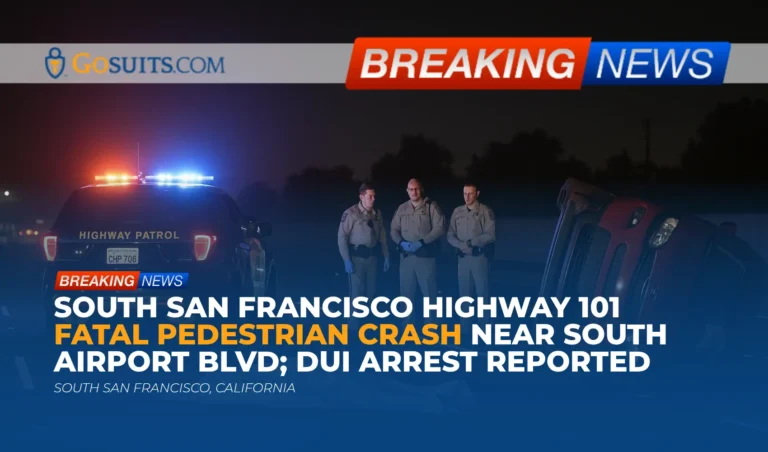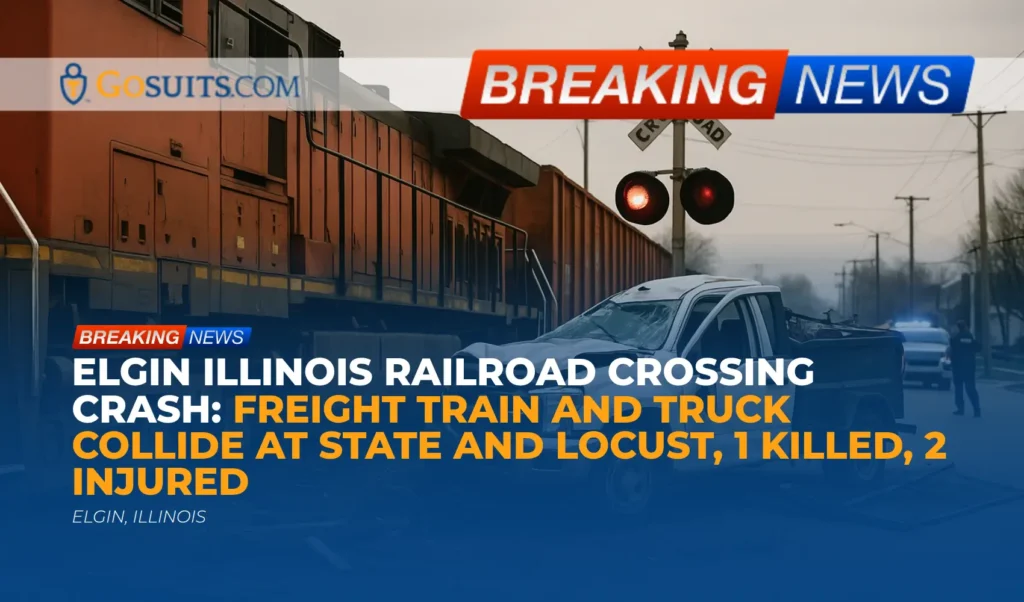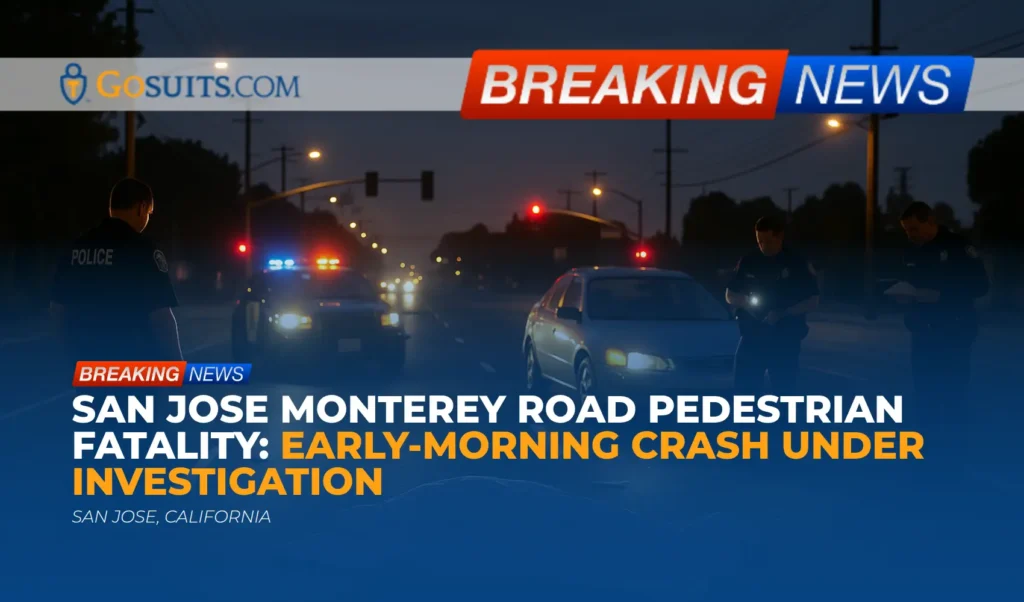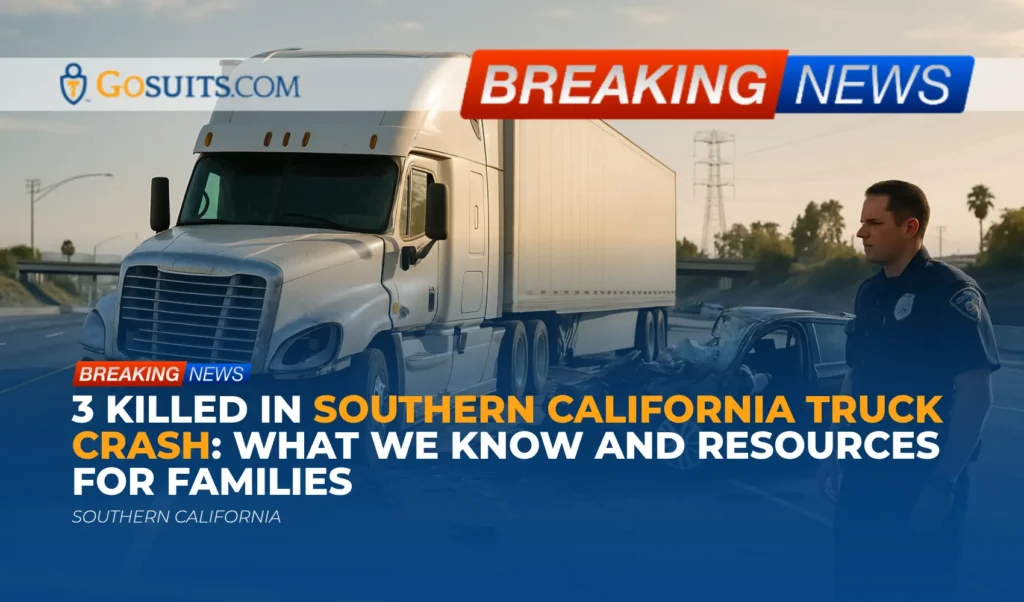- Overview of the South San Francisco Highway 101 incident
- Where and when it happened
- Official response and what is known so far
- Safety context: pedestrians on freeways and nighttime risk
- Secondary collisions and stopped-vehicle danger on highways
- Potential civil liability and insurance considerations in multi-vehicle crashes
- Rights of surviving family members after a fatal crash in California
- What evidence can help and how to get it in San Mateo County and California
- How insurance claims typically unfold after a fatal crash
- Practical steps to take in the days and weeks after a fatal roadway incident
- Key timelines and deadlines in California
- Community and grief support resources
- Commentary from Gosuits South San Francisco, California Personal Injury Attorney
- Action steps that cannot wait
Overview of the South San Francisco Highway 101 incident
According to reports, a tragic chain of events occurred on Highway 101 near South Airport Boulevard in South San Francisco shortly before 3 a.m. on a Saturday. A northbound Hyundai Ioniq struck a man who, for reasons not yet known, ran across the highway and into the vehicle’s path. The Hyundai driver stopped in the slow lane and called 911. While stopped, the Hyundai was then struck by a red Kia Soul that rolled onto its side. California Highway Patrol units arrived, conducted lifesaving efforts, and multiple lanes were closed while officials investigated. Paramedics pronounced the pedestrian deceased at 3:14 a.m. CHP indicated the Kia driver was allegedly under the influence and was arrested on suspicion of DUI. No additional injuries were reported.
These events are heartbreaking for families and communities. High-speed corridors like Highway 101 are not designed for pedestrians, and the combination of darkness, traffic speed, and sudden stops can create conditions where secondary collisions happen quickly. The information below is intended to help families understand what typically happens after incidents like this, what rights may exist under California civil law, and where to obtain key documents needed for insurance and potential civil claims.
Where and when it happened
The incident took place on Highway 101 near South Airport Boulevard in South San Francisco, in the overnight hours just before 3 a.m. This area is a major freeway artery through northern San Mateo County with heavy traffic, including overnight commercial movement. Nighttime conditions can reduce visibility for drivers and make it much harder to detect a person on or near the roadway until it is too late. Freeways are controlled-access roads; pedestrians are generally not permitted on these corridors where posted.
Official response and what is known so far
CHP units responded to the scene and started lifesaving measures for the pedestrian. Emergency medical services pronounced the man deceased at 3:14 a.m. CHP closed multiple lanes for several hours to document the scene, gather evidence, and safely clear vehicles. The red Kia driver was arrested on suspicion of DUI. The investigation will typically include vehicle inspections, roadway measurements, photographs, witness statements, and a review of any available traffic camera or dash camera footage.
For families, it is common to feel overwhelmed by the technical processes that follow. The initial CHP collision report is often not immediately available; it may take days or weeks to finalize. Supplemental reports, diagrams, and any reconstruction analysis can take longer, especially when there are multiple vehicles and a fatality involved.
Safety context: pedestrians on freeways and nighttime risk
California generally restricts pedestrians on freeways where posted, reflecting the extreme danger pedestrians face among fast-moving vehicles. California Vehicle Code section 21960 authorizes freeway operators to prohibit pedestrians by signage because these facilities are not designed for foot traffic. The statute text is available at leginfo.legislature.ca.gov and explains local authority to restrict freeway pedestrian access.
Nighttime strikes involving pedestrians are a well-documented risk. National Highway Traffic Safety Administration data show that the majority of pedestrian fatalities occur in dark conditions. For context, see NHTSA Traffic Safety Facts on pedestrians, which consistently report a high proportion of nighttime pedestrian deaths and alcohol involvement among either drivers or pedestrians. Reference: NHTSA CrashStats.
These general facts do not assign fault in any particular incident. They do provide background as to why freeway corridors are especially hazardous for anyone on foot and why drivers may have limited reaction time in low-light situations.
Secondary collisions and stopped-vehicle danger on highways
The second crash in this event involved a stopped vehicle in a live lane and a subsequent impact by another driver. Transportation safety agencies have long cautioned about secondary crashes that occur after an initial incident, especially on high-speed facilities. The Federal Highway Administration has described secondary crashes as a significant contributor to roadway injuries and fatalities during incident response, underscoring the importance of early detection, quick clearance, and driver awareness. See FHWA incident management resources at ops.fhwa.dot.gov.
When a vehicle must stop after a crash, drivers are expected to do what is reasonably safe under the circumstances, such as activating hazard lights, remaining with the vehicle if it is unsafe to exit, and moving to the shoulder if possible and safe. Real-world conditions vary, and decisions are made in seconds. Investigators will examine where the vehicle came to rest, whether flares or hazard lights were used, and how approaching drivers responded.
Potential civil liability and insurance considerations in multi-vehicle crashes
California civil law looks at whether one or more parties were negligent and whether that negligence contributed to the harm. It is common for investigators, insurers, and courts to consider multiple contributing factors in multi-vehicle events like this. Important principles include:
- Negligence and duty of reasonable care. California Civil Code section 1714 broadly recognizes that everyone is responsible for injury caused by want of ordinary care in the management of their person or property. See leginfo.legislature.ca.gov.
- Comparative fault. California uses a comparative fault framework that allows responsibility to be apportioned among multiple actors, including potentially the decedent, drivers, and others, depending on the facts. The Judicial Council’s civil jury instruction on comparative fault provides general guidance on how jurors may be asked to allocate responsibility. See CACI No. 405 on the Judicial Council site at courts.ca.gov.
- DUI and civil liability. Driving under the influence can be evidence of negligence. In certain civil cases, conduct showing malice or conscious disregard for safety can support claims for punitive damages. Under California Insurance Code section 533, insurers are not liable for a loss caused by the willful act of the insured, which can affect the availability of insurance coverage for punitive damages. See leginfo.legislature.ca.gov.
- Secondary impact liability. When a stopped vehicle is struck, investigators assess whether the stopped position was unavoidable, whether reasonable safety steps were taken, and whether the approaching driver was impaired, speeding, or otherwise inattentive. Responsibility can be shared according to the evidence.
- Potential non-driver parties. Depending on facts not yet known, potential liability can extend to other entities, such as roadway contractors or public entities, only if there is evidence of a dangerous condition of public property and compliance with strict claim procedures under the Government Claims Act. This is highly fact-dependent and requires timely notice. See generally Government Code claims provisions at leginfo.legislature.ca.gov.
Every crash is unique. Families should be aware that initial news reports rarely capture the full factual record. Scene diagrams, vehicle event data recorders, toxicology results, and coroner findings can all bear on liability and insurance outcomes.
Rights of surviving family members after a fatal crash in California
California law authorizes certain family members to bring a wrongful death claim after a fatal incident. This claim seeks compensation for losses the family suffers due to the death, such as the loss of financial support, love, companionship, and household services. The governing statute is California Code of Civil Procedure section 377.60, available at leginfo.legislature.ca.gov.
In some cases, there is also a survival action, which allows the decedent’s estate to pursue claims the decedent could have brought if they had lived, such as certain economic losses up to the time of death. This is addressed in Code of Civil Procedure section 377.30, also available at leginfo.legislature.ca.gov.
These are general frameworks and do not determine fault. Whether these claims are appropriate depends on the facts, including who contributed to the harm and the available insurance coverage.

What evidence can help and how to get it in San Mateo County and California
In fatal freeway events, several official documents and evidence sources can be critical. Timely requests help preserve records and clarify the sequence of events.
- CHP Collision Report. The primary investigative document is the California Highway Patrol collision report. Families or their authorized representatives can request a copy using the CHP 190 form. Guidance and the CHP 190 are available at the CHP website: CHP Collision Reports. It is helpful to have the report number, date, time, and location.
- Supplemental CHP materials. Depending on the case, there may be supplemental narratives, scene diagrams, and photos. Some materials may be withheld during an active investigation. Requests typically go through the area office that handled the collision. Find area offices at chp.ca.gov/find-an-office.
- Coroner records. In San Mateo County, the Coroner’s Office handles postmortem examinations and may generate reports such as autopsy findings and toxicology. Procedures and eligibility for release vary. If a county link is not readily available on a .gov domain, families can call the county coroner’s office directly for instructions. California’s general guidance on death records is available through the California Department of Public Health at cdph.ca.gov.
- Death certificates. Certified copies are often needed for estate and insurance matters. State-level information on obtaining certified death records is at the California Department of Public Health site: cdph.ca.gov.
- Traffic camera and dash camera footage. Caltrans cameras provide snapshots, not always archived video, but timestamps and any privately held dash camera footage from witnesses can matter. Counsel can help issue preservation letters where appropriate.
- 911 audio and dispatch logs. These can provide precise timelines. Requests may go through CHP or local dispatch centers depending on who handled the call. Availability can be time-limited.
- Toxicology data and arrest records. When DUI is suspected, law enforcement may have preliminary and confirmatory test results. Release rules vary; some may only become available after charging decisions. Any criminal process is separate from civil claims, but the records can inform civil liability.
When speaking with agencies, have the incident date, location, approximate time, and any report numbers ready. If interacting directly with insurers, it is prudent to consult an attorney first, because statements to insurers can be used later, and there may be strategic considerations about what to request and when.
How insurance claims typically unfold after a fatal crash
Insurance issues in multi-vehicle freeway crashes can be complex. Several coverages may be implicated, sometimes across multiple policies:
- Bodily injury liability. The at-fault driver’s liability coverage may address wrongful death claims by eligible family members. Allocation among multiple negligent actors is fact-dependent.
- Uninsured or underinsured motorist coverage. If an at-fault driver lacks sufficient coverage, UM/UIM coverage from the decedent’s household policy may apply, depending on policy language and circumstances.
- Medical payments coverage. Some auto policies offer medical payments coverage that may assist with immediate expenses, although terms vary and it may not apply in fatal cases.
- Punitive damages exposure. In cases involving egregious conduct such as DUI, punitive damages may be sought in civil court. Insurance coverage for punitive damages is restricted by California Insurance Code section 533. See statutory text at leginfo.legislature.ca.gov.
Insurers will often move quickly to gather statements and shape the narrative. Before speaking with any insurance adjuster, including one representing the decedent’s own policy, it is wise to consult an attorney. What is said in an early recorded call can affect liability assessments and settlement posture later on.
Practical steps to take in the days and weeks after a fatal roadway incident
There is no right way to navigate the aftermath of a sudden loss. The following steps are practical considerations that can help families organize information and protect their options while prioritizing well-being:
- Designate a family point person. Choose one trusted person to receive calls, track contacts, and keep a shared folder of documents. This helps reduce repeated painful conversations.
- Request the CHP collision report. Use the CHP 190 form and follow instructions on the CHP site at CHP Collision Reports.
- Contact the county coroner’s office. Ask about next steps, timelines for autopsy and toxicology, and the process for requesting reports and personal effects.
- Collect available evidence. Preserve any photos, text messages, travel plans, and witness contacts. If any vehicles are towed, note the tow yard and inventory.
- Avoid early recorded statements to insurers. Consult an attorney first before speaking with any insurance company. Statements can be used later.
- Track all expenses. Keep receipts for funeral costs, travel, grief counseling, and any other related expenses. These may be relevant to claims.
- Mind social media. Consider privacy settings and avoid posting details about the crash or assigning blame while facts are developing.
- Seek support. Grief resources and counseling can be crucial. See public health resources at cdc.gov/mentalhealth.
Key timelines and deadlines in California
California imposes deadlines for civil claims after a fatal incident. Missing a deadline can affect the ability to bring a claim.
- General wrongful death limitations period. In many cases, wrongful death actions must be brought within two years of the date of death under Code of Civil Procedure section 335.1. See text at leginfo.legislature.ca.gov.
- Government entity claims. If a public entity may be involved, a government claim is generally required within six months of the incident under Government Code section 911.2, with limited exceptions. Statutory text is at leginfo.legislature.ca.gov.
- Insurance notice deadlines. Policies often require prompt notice. Before contacting any insurer, it is prudent to speak with a lawyer so communications can be properly managed.
There are exceptions and special rules for certain claim types. Timely evaluation by a knowledgeable advocate helps ensure the right deadlines are tracked.
Community and grief support resources
Support systems can make a difference after sudden loss. Publicly available resources include:
- Mental health resources. The Centers for Disease Control and Prevention provides information on coping with grief and stress at cdc.gov/mentalhealth.
- Traffic safety data and awareness. The California Office of Traffic Safety offers statewide crash trends and safety programs that can help communities understand and reduce risks. See ots.ca.gov.
- Local victim services. Counties often provide victim assistance and crisis response, sometimes administered through district attorney or health departments. If a direct .gov link is not readily available, calling the county main line and asking for victim services or behavioral health is a starting point.
Commentary from Gosuits South San Francisco, California Personal Injury Attorney
Our hearts go out to everyone affected by the fatal crash on Highway 101 near South Airport Boulevard. This discussion is offered for educational purposes and general information only. It is intended to help families understand the processes and issues that often follow a sudden roadway death.
Based on the reported facts, there appear to be two distinct events: an initial pedestrian strike and a secondary collision involving a stopped vehicle and an allegedly impaired driver. Multi-stage incidents like this are complex. Investigators will work to determine how each event unfolded, who had the ability to prevent harm at each step, and how the roadway environment and darkness factored into driver reaction times. Allegations of DUI can influence both the civil liability analysis and how insurers evaluate exposure, but a complete assessment usually requires official reports and, in fatal cases, coroner findings.
In our experience, insurers and large corporations often move quickly after serious incidents to shape the narrative and minimize their own financial exposure. Adjusters may request recorded statements from grieving families, ask for broad medical authorizations, or float early settlement numbers before the full picture is known. These tactics can capitalize on a lack of familiarity with the claims process. Once a statement is recorded or a release is signed, it can be difficult to correct the record or pursue full accountability later.
A free consultation with a seasoned attorney can provide clarity about rights, deadlines, and the types of evidence that matter most. It can also help families avoid common pitfalls in early communications with insurers. Even a brief conversation can help prioritize which records to request first, how to preserve evidence, and what to avoid saying in calls that may be recorded.

Action steps that cannot wait
After a fatal freeway incident, certain time-sensitive steps can protect options and reduce uncertainty:
- Secure the CHP report. Submit a request using CHP Form 190 as soon as feasible. See CHP Collision Reports.
- Preserve evidence now. Ask tow yards to hold vehicles without alteration, retain any damaged personal items, and document all communications. Where appropriate, counsel can send preservation letters to agencies and businesses that may have video or data.
- Coordinate with the coroner. Confirm timelines for autopsy and toxicology and the process to request reports when available. Keep copies of all correspondence and case numbers.
- Avoid recorded statements to insurers. Before any insurance call, consult an attorney. Statements given in the first days can be used to contest liability later.
- Calendar deadlines. Note the general two-year period for wrongful death in California and the six-month claim deadline if any government entity may be involved. See Code of Civil Procedure section 335.1 and Government Code section 911.2 at leginfo.legislature.ca.gov.
- Organize a document file. Keep a central folder for incident numbers, contact lists, medical and funeral receipts, employment records, and any insurance correspondence. This reduces stress and duplication later.
Taking these steps early can make the difference between uncertainty and a clear, informed path forward. Acting promptly matters because evidence can be lost, memories fade, and deadlines approach quickly even while families are grieving.
Additional legal context and safety references
For readers who want to dig deeper into the laws and safety research discussed above, the following public sources may be useful:
- California Vehicle Code. Pedestrian restrictions on freeways and related provisions are authorized under Vehicle Code section 21960. Access the code at leginfo.legislature.ca.gov.
- Comparative fault. The Judicial Council of California Civil Jury Instructions (CACI) provide general guidance on allocating fault in civil cases, including CACI No. 405. See courts.ca.gov.
- NHTSA pedestrian safety data. National pedestrian fatality trends and risk factors are summarized by NHTSA at crashstats.nhtsa.dot.gov.
- California Office of Traffic Safety. Statewide quick stats and program information are at ots.ca.gov.
- FHWA incident management. The FHWA’s materials on traffic incident management and secondary crash prevention are at ops.fhwa.dot.gov.
- California Insurance Code section 533. Restriction on insurance coverage for willful acts is at leginfo.legislature.ca.gov.
- Wrongful death and survival statutes. Code of Civil Procedure sections 377.60 and 377.30 are accessible at leginfo.legislature.ca.gov.
These materials can help families and community members understand the general legal framework and safety considerations without relying on speculation about any single case.






